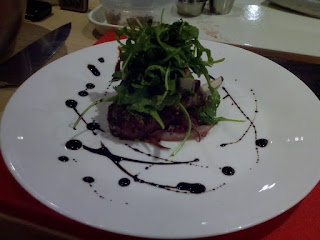My modifications: reduced the salt by 1 tsp and substituted 1/2 cup spelt flour for 1/2 cup of the all purpose flour. My son helped me make it so we also added raisins and cinnamon to one of the loaves.
Turned out pretty tasty, but since I didn't let it rise enough it was quite dense! The kids loved it (of course).
Sad that in these pandemic times, I may have a hard time refilling my low yeast and flour reserves. (At least I can eat!) Maybe I can convert my remaining yeast packet into a sourdough starter, but I don't really like sourdough...
 |
| You can see that my airpockets are nothing like SimpleEverydayHome's. So if you love that fluffy French bread, then Let It Rise! |
Ingredients
- 4.5 cups flour and ~1 cup reserve
- 0.5 cup spelt flour
- 2.5 tsp salt
- 1 packet or four and a half tsp yeast
- 1 tbsp sugar
Equipment
- food processor with dough blade
- large glass bowl
- microwavable measuring cup
- oven
 |
| Shortly after adding to the oven. If you let yours rise, they'll be bigger than this. |
Steps
- Preheat oven to 200° F and move the top rack to its lowest position.
- For crustier bread: put a metal pan at the bottom rack.
- Use your plastic dough blade in the food processor.
- Add 4.5 c flour, spelt flour, salt, sugar, yeast.
- Pulse to combine a bit.
- Heat 2 c of water in the microwave for 1 minute high -- enough to be hot but not burning (about 125° F).
- Add 2 tbsp olive oil into heated water.
- Turn on your blade while pouring the water-oil mixture through your pour hole.
- Spin for a bit more to get things mixed. Don't overwork your food processor.
- If the dough is still wet (likely it will be), add some reserved flour and spin some more. Repeat until you have a fairly smooth ball of dough.
- Don't add more flour than necessary. My dough was still a bit sticky.
- Add some olive oil to a large glass bowl.
- Rub the oil around the bowl.
- With your oily hand, transfer the dough from the food processor to the bowl.
- Wiggle the dough around and flip it over to get it coated in oil.
- Turn off the oven.
- Cover the bowl with a light metal lid and place it in the oven.
- Wait for 30 min or until doubled in size.
- Grease a large baking sheet while you wait.
- Once raised, punch down the dough and split into two pieces.
- Floured your counter and flatten one piece of your dough.
- Press it out to be 30 cm (a foot) wide, 1.5 cm (1/2") tall, and however long.
- Roll it up along the length. As you roll, pinch the bread together to reduce the spiral lines in the finished loaf. This part took pretty long and next time I'll rub the top with a bit of water and skip the pinching.
- Move the loaf onto your greased baking sheet and tuck the ends under for a squarer finish.
- Repeat for second piece. (Or additionally, sprinkle some raisins and cinnamon on top before you roll for a tasty low-sugar raisin bread.)
- With a sharp knife, cut diagonal slashes across the top of the loaves about 3 cm (1.2") apart.
- Wait for 30 min for it to rise again.
- Preheat oven to 375° F.
- Your loaves should have doubled in size. If you're impatient (like me) with this rise step and don't let them double, then your loaf will be dense but still enjoyable.
- For crustier bread: add 2 c water to the bottom rack metal pan.
- Bake for 27 minutes.
- Allow bread to cool 3 minutes before slicing.






































